Insufficient Inventory
One of the major hurdles facing the summer housing market is the lack of homes for sale. Comparing data from June 2022 and June 2019, new listings have decreased by 25.7% and 28.8%, respectively. Although there are technically more homes on the market compared to the previous year, many properties are not selling. Homes that require significant renovations, possess unattractive features, are overpriced, or are not ideally located are struggling to attract buyers due to the current high cost of homeownership. Desirable properties in good condition and sought-after locations, however, continue to sell quickly.
Impact of Mortgage Rates
The housing market slowdown can be attributed in part to higher mortgage rates. The U.S. Federal Reserve, aiming to address inflation and stabilize the housing market, has raised interest rates, resulting in larger monthly mortgage payments. As a result, many prospective homebuyers, particularly first-time buyers, are unable to afford homes, hindering their ability to enter the market. Furthermore, economists predict that mortgage rates will remain relatively high in the mid-to-high 6% range until the Federal Reserve implements rate cuts, potentially further dampening buyer demand.
Price Adjustments
Home prices are expected to experience slight declines during the summer as buyers reach their financial limits. Nationally, list prices have fallen by 0.9% compared to the previous year, albeit not significantly enough to alleviate the impact of high mortgage rates on homebuyers. Price declines are more pronounced in expensive regions, especially in the Western and Southern parts of the country, while prices continue to rise in more affordable Midwestern and Northeastern markets. The overall price trend depends on the specific locality, with varying predictions from experts.



